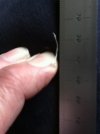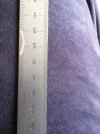Run of the mill 420J has anywhere from 0.15 to 0.36% Carbon, 420 HC has 0.45%.
This means that, at its best, 420J is 0.09% behind 420HC in Carbon content...
According to this source:
http://www.simplytoolsteel.com/420HC-stainless-steel-data-sheet.html
420 HC can be hardened to 56-59 RC: Pretty much the same as any 440C.
Buck 110 users on this forum have routinely commented that 420 HC will outperform the other steels they can get on the 110. There is no real reason to think 420J is much different than that, and depending on carbon content and cleanness, it could even be the case that one source over another reverses this presumed "hierarchy".
CPM-3V knife was a Survive! GSO-10. It was not affected by -30C weather, so at this temperature it vastly outperformed the Chinese 420J. CPM-3V even seemed to do
better in the cold than it did in normal temps...
The S30V I tested was on an $2000 RJ Martin "Blackbird" (10.5" blade) "The Vanguard collection" #12 of 20, and it was tested continuously over two years, trying to cold-sharpen it out of a hypothetical "bad layer". After two years of watching it micro-fold its apex on Maple from
single or less than
5 hits, I finally realized it was just hard to sharpen steel that would not hold an edge. CPM 154 was from a $700 Martin Knives, and was the same.
The Gerber Mark II 70th anniversary in S30V would micro-fold from
single or double slices in the 1/8" thick cardboard of a 12 pack Evian water bottle box. After that I concluded S30V was not suitable for knife steel.
By micro-folding I mean only detectable with nail shavings.
By comparison, a United Cutlery Rambo II clone (420J) was chopped about 50 times into Maple (18 dps+20 dps micro bevel), and, testing by slicing phonebook paper and nail rubbing, no fine edge or rolling loss was detectable, to the point that
no touch-up was required. A similar (but less well made) Master Cutlery RII clone, also in 420J, went up 100-120 hits with no detectable loss: Only minor edge loss at 200 hits, no rolling: The best of any steel I have ever tested, ignoring the numerous variables. (Including my INFI Battlesaw which did nowhere near as well, the edge warping from side to side easily, despite being convexed, and generally thicker edged than the United, although the 10 extra ounces weight made it hit much harder, which does stress a thin convex edge more)
420J was also among the easiest to sharpen, like a perfect cross between Carbon steel and Stainless: The steel I wish all my knives were made of...
If Buck does well with 420HC, do you really think there is any appreciable difference because 420J has 0.09% less Carbon? I really doubt it.
Gaston
420J vs CPM 3V: About 40 hits on Maple (one very bad mis-hit on the MC explain the one short nail shavings area)
S30V: 2-3 hits on Maple in two separate edge areas (so 4-6 hits total): You can see the nail shavings from separate micro-folded areas from the intended separate areas of the very few hits. Over 2 years and many re-sharpenings, the result was always the same:
G.




